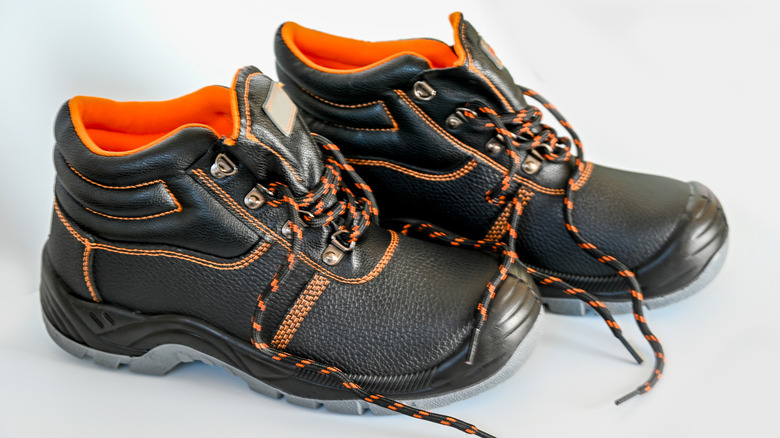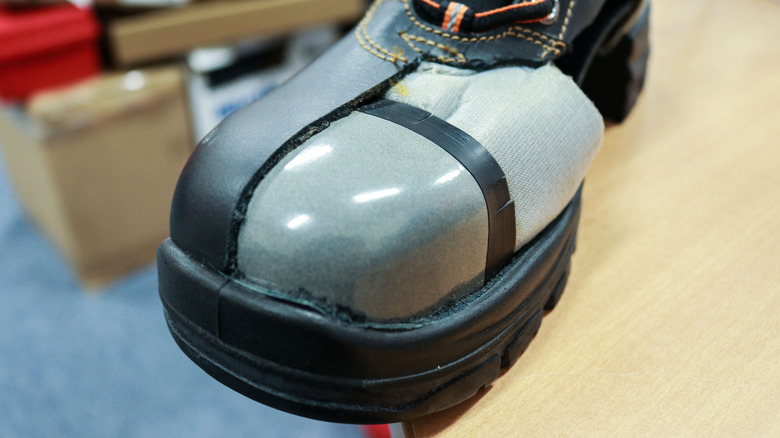Do Steel Toe Boots Actually Protect Your Toes? Here's What You Need To Know
Among the service sector, construction, transportation, and retail are the industries where people have the most risk exposure. From these, construction had the highest number of workplace injuries, according to a study from the National Safety Council, with over 4 million in 2023 alone. This sobering statistic is why it is crucial for workers in any risk-prone field to always use different types of safety gear while at work to prevent injuries. Among the most important safety equipment are steel-toe boots, because they can protect the feet from various types of harm or damage.
Steel-toe boots are built to withstand rigorous use and provide maximum protection for the wearer. Composed of several sections, the biggest of which is the upper, or external, section, which is made of different materials like leather or rubber. Next is the inner lining constructed from fabrics, followed by the padding, which, like the lining, makes the boot more comfortable to use. For ground contact, the boot has the outsole, which is the thick layer at the bottom and is made from high-strength rubber. Lastly, as its name indicates, the boot has a steel toe, or protective toe cap, located at the front section, which is the most important and reinforced part of the shoe.
To prevent injury to the wearer, a steel-toe boot provides several levels of protection. First, it safeguards the foot from impact from falling objects, which comes from the steel toe, aided by the thick external section. To prevent slipping, most steel-toe boots have non-slip rubber outsoles that provide grip and traction on most surfaces. Against punctures, some boots have a steel or anti-perforation midsole, which protects against punctures from broken glass or nails.
Optimal foot protection with tough boots
Modern safety shoes came from the gradual development of better workplace practices and worker safety, as a result of the labour movement from the time of the Industrial Revolution. During this period, workers were wearing wooden clogs called "Sabots", which later transitioned to leather shoes that were more comfortable to wear. By 1934, an American shoe manufacturer called Red Wing Shoe Company created the first safety footwear that incorporated a steel toe in its shoe, which is now a standard feature on steel-toe boots, similar to the Dewalt-branded work boots.
Safety wear, including steel-toe boots, must meet rigorous quality standards from the American Society for Testing and Materials, or ASTM. Specifically for safety footwear, the boot is tested by ASTM 4213 guidelines, which specify the critical protection level that the shoe must adhere to. These requirements include the ability to resist impact, puncture, chainsaw cuts, and compression; electric shock shielding; metatarsal bone protection; and static electricity dissipation. It is important to note that the United States Occupational Safety and Health agency mandates that safety shoes conform to ASTM standards under regulation 1910.136
Wearing safety shoes is mandatory, as this is required by the Occupational Health and Safety Act for workplace safety that was enacted in 1970. Under this law, safety shoes are required to be used if there is a risk of foot injury as a result of electrical shock, falling objects, or shoe penetration from various materials in the workplace. Alongside providing crucial protection against various hazards, using personal protective equipment, like hard hats and safety glasses from Harbor Freight, ensures regulatory compliance, minimizes costly downtime, avoids costly penalties and legal expenses, and creates a more efficient workplace by making workers feel safe and secure at their jobs.

